
Interior
As well as thumbscrews, the two large side panels use a hinged system to attach, something we really hope becomes more common, and thick but soft foam is affixed to the inside of both as a means of deadening noise. A firm tug on the roof panel lets you pull it clean off, and it's one of the heftiest roof panels we've come across. While its shape is formed from plastic, it has a steel outer cover and is also fully lined with foam.Sadly, the front panel on our sample was all but impossible to remove, with the clips holding it in place simply refusing to give way no matter how much pressure any of us applied. While this is a fairly serious flaw, we've been assured by an NZXT representative that the company is aware of the issue, and that it has been addressed for the production of retail units (expected in June). From what we could see, however, the front panel is akin to the roof one, with a plastic body, steel shell and foam lining.
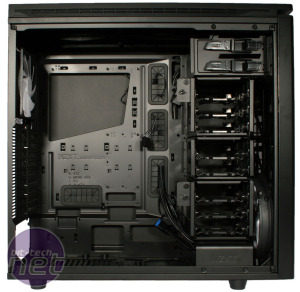
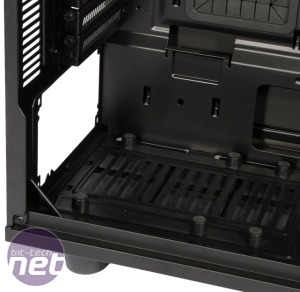
Click to enlarge - The interior of the H630 includes pre-installed motherboard mounts and vibration absorbing feet for the PSU
The all black interior sports a massive motherboard cutout, pre-installed ATX board mounts and clearly labelled mounting holes for other form factors. The PSU area has anti-vibration feet and good ventilation, but there's no padding where the PSU meets the case. It's not likely to make much difference, but it's an odd oversight for a case geared towards silence. Elsewhere, each of the nine PCI brackets are held by thumbscrews and fully reusable.
The internal cables are sleeved nicely in black, and NZXT also does some basic cable routing for you too. As with the Phantom 630, the H630 comes equipped with the NZXT Grid fan hub behind the motherboard tray. Via a single molex connection (which also powers the I/O lighting), this hub powers up to ten fans via three pin connections. The two included fans are wired and ready to go, and an extra cable for a third is provided too. Bundled case fan controllers are often only able to control three fans, so it's even more of shame NZXT hasn't included one with the H630, as coupled with the Grid it would be a very powerful addition.
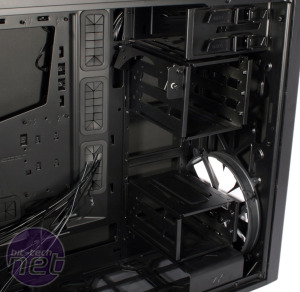
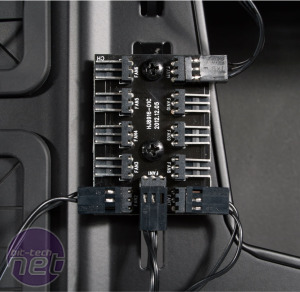
Click to enlarge - The H630 includes modular drive cages with internal fan mounts and an NZXT Grid fan hub
The optical drive shields are held in place by screws, and while we couldn't install one ourselves because of the front panel issues, the metal clips designed to hold them are very secure, and inspire confidence that you'd have no issues in this area.
As for internal drives, NZXT again sticks to a modular design. Three cages that can hold three, three and two drives respectively can all be removed and installed individually. Both of the three-bay cages also have a 140mm/120mm fan mount on the back of them that can be angled to point towards graphics hardware, for example. The system still gives you some flexibility as to the layout of your drives, but it's not as versatile the Phantom 630, where you only need as many drive bays as you have drives, and where the cages themselves could be stacked in any order.
The drive trays themselves slide out to the right of the case, not the left, for no real benefit. As is common, SSDs require screws, whereas the trays are designed to bend around and clip 3.5-inch drives into place with pins that are backed by rubber to soften vibrations. Sadly, NZXT continues to peddle out the same flimsy, loose, plastic drive trays we've previously bemoaned. They may be functional, but they're poor alternatives to the metal trays from Fractal, for example, and something of a stain on an otherwise excellent build quality. On the plus side, two SSD trays behind the motherboard tray provide extra storage space and thankfully can be utilised regardless of whether or not the motherboard is installed.
A 360mm radiator can be fitted in the roof of the case (where 280mm and 240mm radiators are also supported), but with only 65mm of room to play with you're limited to half height rads with a single set of fans; anything bigger risks clashing with your motherboard. The front of the case supports the same radiators, but 360mm or 280mm set-ups necessitate the removal of all drive cages. While doing this creates easily enough space for a full height model in push/pull, it's perplexing that NZXT has removed the option seen in the Phantom 630 to move one of the modular drive cages further back into the case, as anyone wanting to use such a radiator in the front will have to get creative in 3.5-inch drive placement or do without.
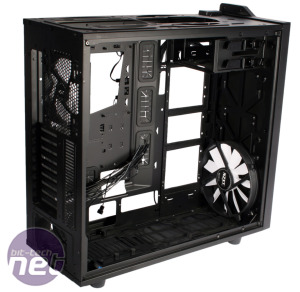
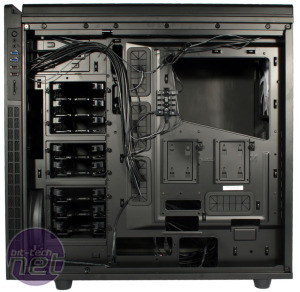
Click to enlarge - There's lots of room for water-cooling at the front and bottom, and plenty of cable routing options too
The bottom fan mounts also support both 240mm and 280mm radiators, provided the front 200mm fan is relocated. Half height models with a pair of fans will fit underneath the drive cages, allowing you to keep them all installed should you choose. However, even a full height rad with push/pull fans will leave room for at least five drive cages hanging from the 5.25-inch bays, or a second 240mm radiator set-up mounted to the front panel. All in all, it's a very healthy amount of support for liquid coolers, but a few sensible design decisions could improve the H630 even further in this regard.
The last thing to discuss about the H630's interior is cable management, and in this area it excels. There are plenty of large routing holes around the motherboard tray, with the grommets used for them being both flexible and very secure. There's also loads of space for thick cables, and the abundance of zip ties and hooks as well as the hinged side panel means you should have no trouble keeping everything tidy.

MSI MPG Velox 100R Chassis Review
October 14 2021 | 15:04

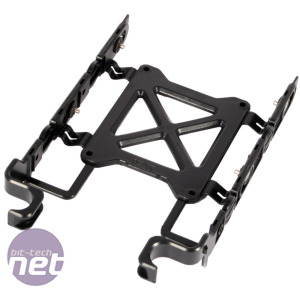
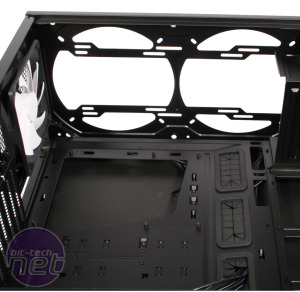







Want to comment? Please log in.